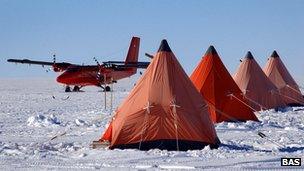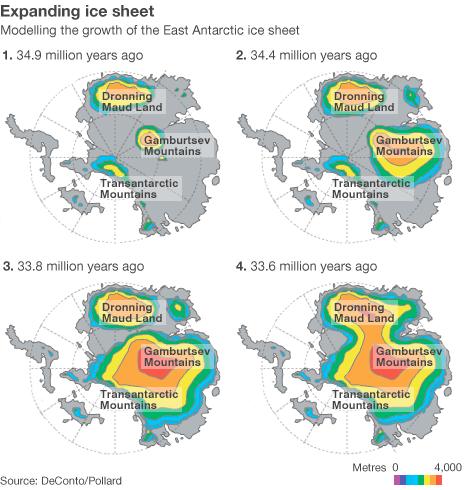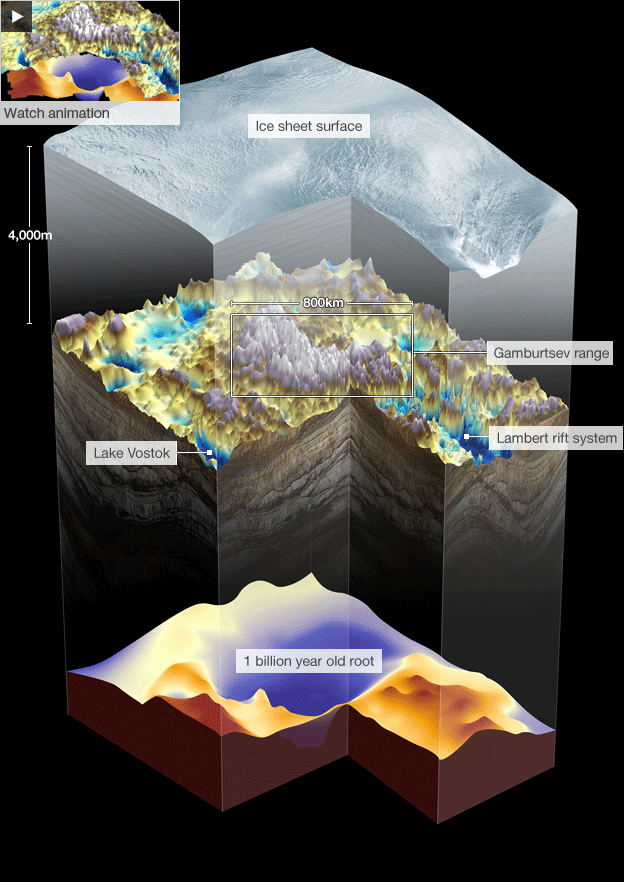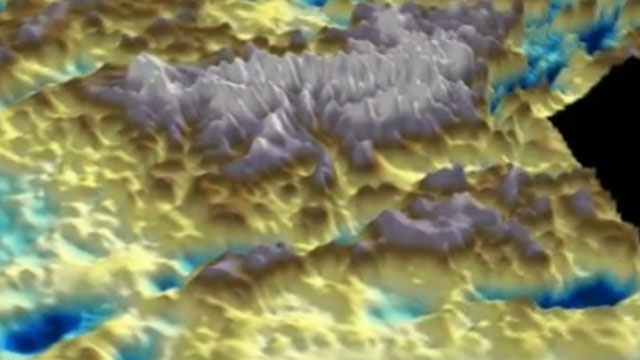Gamburtsev 'ghost mountains mystery solved'
- Published

The survey required the scientific and logistical support of seven nations
Scientists say they can now explain the existence of what are perhaps Earth's most extraordinary mountains.
The Gamburtsevs are the size of the European Alps and yet they are totally buried beneath the Antarctic ice.
Their discovery in the 1950s was a major surprise. Most people had assumed the rock bed deep within the continent would be flat and featureless.
Survey data now suggests the range first formed over a billion years ago, researchers tell the journal Nature, external.
The Gamburtsevs are important because they are thought to be the location where the ice sheet we know today initiated its march across Antarctica.
Unravelling the mountains' history will therefore inform climate studies, helping scientists to understand not just past changes on Earth but possible future scenarios as well.
"Surveying these mountains was an incredible challenge, but we succeeded and it's produced a fascinating story," Dr Fausto Ferraccioli from the British Antarctic Survey (BAS) told BBC News.
Dr Ferraccioli was a principal investigator on the AGAP (Antarctica's Gamburtsev Province) project.
This multinational effort in 2008/2009 flew aircraft back and forth across the east of the White Continent, mapping the shape of the hidden mountain system using ice-penetrating radar.
Other instruments recorded the local gravitational and magnetic fields, while seismometers were employed to probe the deep Earth.
Fausto Ferraccioli: They were a total surprise when first found
The AGAP team believes all this data can now be meshed into a credible narrative for the Gamburtsevs' creation and persistence through geological time.
It is a story that starts just over a billion years ago, long before complex life had formed on the planet, when the then continents were drifting together to create a giant landmass known as Rodinia.
The resulting collision pushed up the mountains, and also produced an underlying thick, dense "root" that sat down in the crust.
Over the course of hundreds of millions of years, the peaks would have gradually eroded away. Only the cold root would have been preserved.
Then, about 250-100 million years ago, when dinosaurs roamed the planet, the crust started to pull apart in a series of rifting events close to the old root.
This rifting warmed and rejuvenated the root, giving it the buoyancy needed to lift the land upwards once more to re-establish the mountains.
Further uplift still was achieved as deep valleys were later cut by rivers and by glaciers.
And it would have been those glaciers that also wrote the final chapter some 35 million years ago, when they spread out and merged to form the East Antarctic Ice Sheet, entombing the Gamburtsevs in the process.

The Gamburtsevs were a nucleation point for the East Antarctic Ice Sheet
"This research really solves the mystery of how you can have young-looking mountains in the middle of an old continent," said US principal investigator Dr Robin Bell from the Lamont-Doherty Earth Observatory of Columbia University.
"In this case, the original Gamburtsevs probably completely eroded away only to come back, phoenix-like. They've had two lives," she told BBC News.
A proposal is likely to go to funding agencies soon to drill into the mountains to retrieve rock samples. These samples would confirm the model being put forward in the Nature publication.
The search also goes on for a suitable place in the range to drill for ancient ice.
By examining bubbles of air trapped in compacted snow, it is possible for researchers to glean details about past environmental conditions, including temperature and the concentration of gases in the atmosphere such as carbon dioxide.
Somewhere in the Gamburtsev region there ought to be a location where ices can be retrieved that are more than a million years old. This would be at least 200,000 years older than the most ancient Antarctic ice cores currently in the possession of scientists.
To some extent, however, the AGAP survey has actually depressed this quest. The radar data has indicated the base of the sheet has been severely disrupted by water that has been freshly frozen, layer upon layer, on to the bottom of the ice column.
- Published3 March 2011

